Did you know that having a bird feeder in your garden can attract a stunning variety of bird species? From colorful hummingbirds to cheerful songbirds, these feathered visitors can bring life and beauty to your outdoor space. But with so many bird feeders on the market, how do you choose the right one to entice these winged wonders? Don’t worry, we’ve got you covered!
Whether you’re a seasoned bird enthusiast or a beginner looking to start your bird-watching journey, our practical feeding tips and stylish designs will help you create a bird haven in your backyard.
Try Different Types of Traditional Bird Food
Bird seed is the most common bird food option, but if you want to attract a wider variety of birds to your garden, you should consider offering a mix of different foods. By providing a diverse selection of bird food, you can entice various bird species to visit your garden and enjoy a feast.
Here are a few traditional bird food options that you can try:
- Black Oil Sunflower Seeds: These seeds are a popular choice among many bird species. They have a high oil content and provide birds with essential nutrients.
- Sugar Water: Hummingbirds are particularly attracted to sugar water. Place a hummingbird feeder filled with this sweet concoction to attract these delightful creatures.
- Suet: Suet is a concentrated source of energy, especially during colder months. It’s a favorite food of woodpeckers, chickadees, and other insect-eating birds.
- Fresh Fruit: Birds like orioles and tanagers are especially fond of fresh fruits such as oranges. Hang slices of fruit on a bird feeder or near a fruit-specific feeder to attract these colorful species.
Offering a variety of bird food will help you attract a diverse range of bird species to your garden. Watch as different birds visit your feeders and delight you with their presence.
| Bird Food | Description |
|---|---|
| Black Oil Sunflower Seeds | High-oil content; attracts a wide variety of bird species |
| Sugar Water | Specifically attracts hummingbirds; rich in energy |
| Suet | Concentrated energy source; loved by woodpeckers and chickadees |
| Fresh Fruit | Appeals to orioles and tanagers; provides natural sweetness |
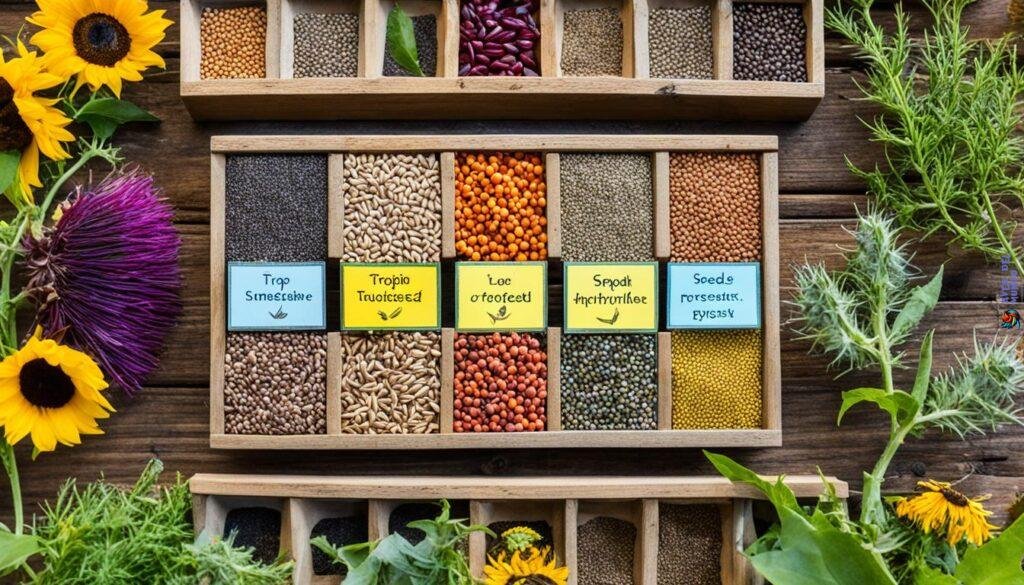
With these different types of traditional bird food, you can create a buffet that will attract various bird species to your garden. Experiment and observe as different birds visit your feeders and delight in the food you’ve provided.
Let Them Eat Worms
Some bird species, especially bluebirds, have mealworms as their favorite food. These high-protein insects are a great way to attract bluebirds and other insect-eating birds to your garden. You can easily purchase live or dried mealworms at pet supply stores or online.
By adding mealworms to your bird feeders, you provide a delicious and nutritious treat that is sure to entice bluebirds and other birds to visit your garden regularly. The high protein content of mealworms makes them an excellent food source, especially during the breeding season when birds require extra energy.
Mealworms can be fed all year round, and they are particularly beneficial during the spring and summer months when birds are actively raising their young. Offering mealworms to your feathered friends ensures they have a reliable source of food to support their nesting and parenting responsibilities.
The Benefits of Mealworms
There are several reasons why mealworms are a favored food among bluebirds and other bird species:
- High in protein: Mealworms are packed with protein, which is essential for birds’ growth, development, and overall health.
- Easy to digest: Birds can quickly consume and digest mealworms, extracting maximum nutritional value from this food source.
- Attractive scent and taste: The aroma and taste of mealworms are irresistible to bluebirds and other insect-eating birds, making them more likely to visit your garden.
How to Attract Bluebirds with Mealworms
Here are some tips on effectively using mealworms to attract bluebirds to your garden:
- Offer mealworms in a dedicated feeder: Use a specific feeder designed to hold mealworms, keeping them fresh and easily accessible to the birds. This allows you to control the quantity and monitor the consumption of mealworms.
- Place the feeder strategically: Position the feeder in an open area with good visibility for the birds, ensuring they can easily spot and access the mealworms.
- Provide other food sources: While mealworms may be the favorite food of bluebirds, it’s also important to offer a variety of other foods such as seeds, suet, and fruit to attract a diverse range of bird species to your garden.
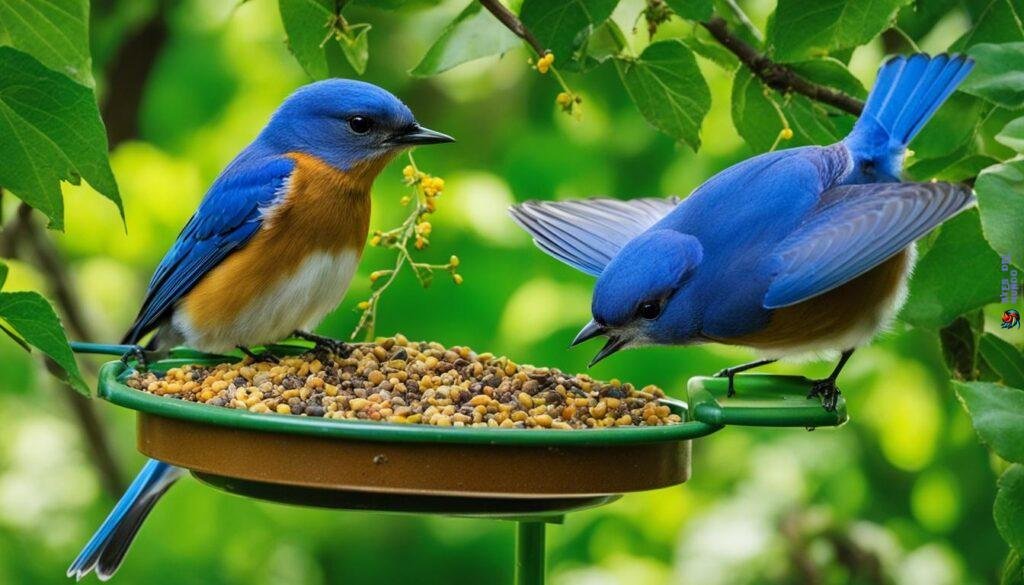
By incorporating mealworms into your bird feeding routine, you can create a bird-friendly environment that attracts bluebirds and provides them with their favorite food. Enjoy the sight of these vibrant birds as they visit your garden and bring their melodious songs to your outdoor space.
Think Beyond the Feeder
While bird feeders are popular for attracting birds to your garden, it’s important to remember that some species prefer to feed on the ground. Sprinkling seed directly onto the floor can entice ground-feeding birds and provide them with a natural feeding environment.
- Choose a suitable spot in your garden where you can easily sprinkle the seed.
- Opt for a variety of quality birdseed that appeals to ground feeders, such as millet, cracked corn, and oats.
- Keep in mind that the type of birdseed you choose may attract specific ground-feeding birds, so research their preferences.
- Regularly replenish the seed to ensure a steady supply for the birds.
- Monitor the area for any signs of pests or unwanted visitors, ensuring the ground feeding area remains safe for the birds.
Remember, while ground feeding provides a natural and attractive feeding option for birds, be cautious if you have young children or pets, as some seeds may be poisonous or pose a choking hazard.
Common Ground-Feeding Birds and Their Preferred Seeds
| Bird Species | Preferred Seeds |
|---|---|
| Dark-eyed Junco | Millet, sunflower seeds |
| White-throated Sparrow | Millet, cracked corn, sunflower seeds |
| American Goldfinch | Thistle (nyjer) seeds |
| Eastern Towhee | Millet, cracked corn, sunflower seeds |
Understanding the preferences of different ground-feeding birds and providing them with their preferred seeds will increase the chances of attracting a diverse range of bird species to your garden.

Keep Visiting Bird Species Safe
When inviting birds to feed in your garden, it’s important to ensure their safety. Providing natural shelter and maintaining a safe feeding environment will ensure a positive experience for both you and the birds.
First and foremost, provide natural shelter by planting trees, native plants, and bushes around your bird feeding area. This will give visiting birds a sense of security and protection from predators.
Next, consider the placement of your bird feeder. To maintain a safe feeding environment, it’s recommended to have an appropriate distance of 6-7 feet between the feeder, bird house, and bird bath. This spacing helps prevent potential conflicts between birds and allows them to feed without feeling crowded or threatened.
By providing shelter and maintaining an appropriate distance, you can create a welcoming and safe environment for visiting bird species. This will encourage them to return to your garden time and time again.

Keep Those Bird Feeders Clean
Cleanliness is key when it comes to maintaining your bird feeders. Regularly cleaning your feeders not only keeps them looking their best but also helps prevent pests from taking over. It’s especially important to pay close attention to the cleanliness of your hummingbird feeders to ensure a safe and attractive meal for these delicate birds.
Pests like squirrels and ants can be persistent in their attempts to get at the bird food, but by keeping your feeders clean, you can minimize their presence and protect the bird food for the intended feathered visitors. Unclean feeders can lead to the spread of diseases among the birds, which can be harmful to their health.
Hummingbird feeders, in particular, require extra attention due to the nature of the food they offer. The sweet nectar can attract insects and mold if left uncleaned. Regularly rinsing the feeder with hot water and using a brush to remove any residue will help keep it safe and appealing to hummingbirds.
Establishing a cleaning routine for your bird feeders is a simple yet vital task. By following a few steps, you can ensure that your feeders are always in pristine condition:
- Disassemble the feeder and remove all parts, including perches and trays.
- Soak the parts in a mixture of one part bleach to nine parts hot water for about 10 minutes.
- Scrub each part with a brush to remove any dirt or debris.
- Rinse thoroughly with clean water to remove any residue left by the bleach solution.
- Allow the parts to dry completely before reassembling the feeder.
Regular maintenance of your bird feeders will not only keep them clean and pest-free but also ensure that the birds have a safe and inviting place to enjoy their meals. So take the time to clean your feeders regularly and keep those feathered friends coming back for more!
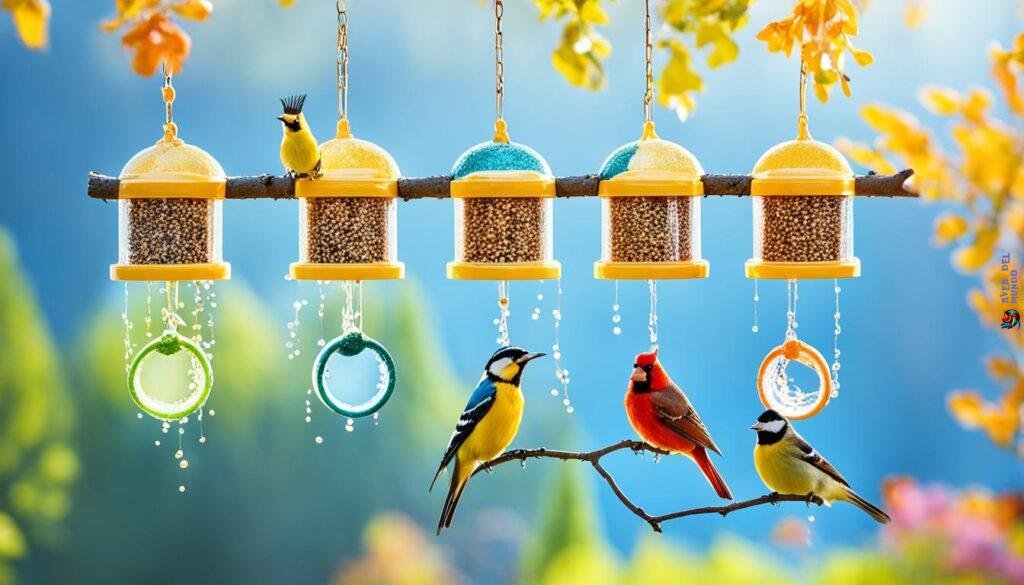
Try a Little Peanut Butter
Many bird species, including woodpeckers, chickadees, and nuthatches, are attracted to peanuts. To enhance the variety of birds visiting your garden, consider adding peanut pieces or all-natural peanut butter to your bird feeder. The scent and taste of peanuts can be irresistible to these feathery friends, providing them with a delicious and nutritious treat.
One creative way to utilize peanut butter is by creating a DIY peanut butter bird feeder. Start by spreading a generous layer of peanut butter on a toilet paper roll or pinecone. Then, roll it in bird seed, ensuring that the seeds stick to the peanut butter. Hang the feeder in a tree or place it on a platform, and watch as birds flock to enjoy the satisfying combination of peanuts and seeds.
Not only can peanut butter attract woodpeckers, chickadees, and nuthatches, but it can also draw in other species that enjoy this nutty delight. Birds will quickly learn to associate your garden with their newfound peanut butter feast, making it a popular destination for birdwatching enthusiasts.
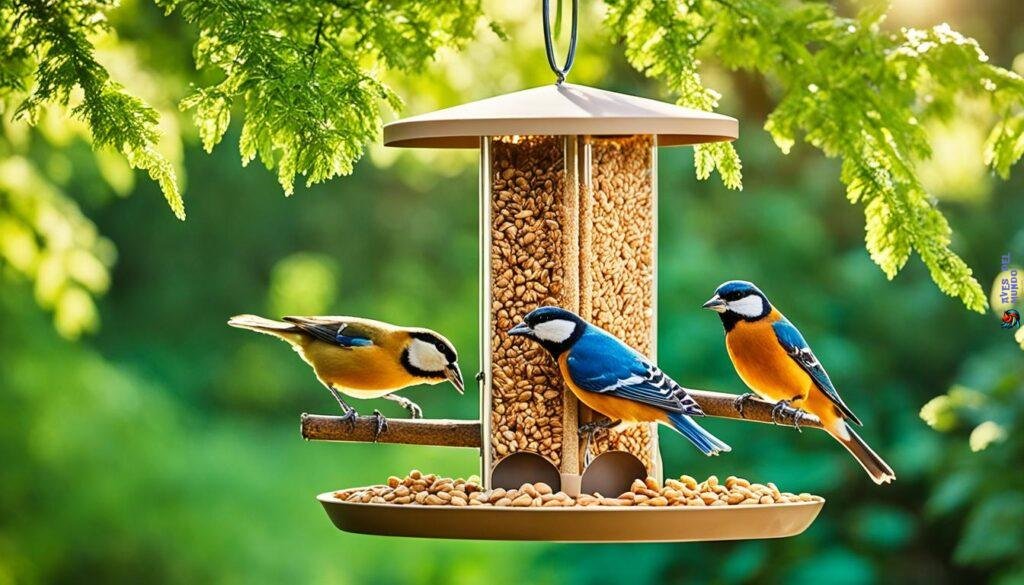
Recommended Peanut Butter Bird Feeder Recipe:
| Ingredients: | Instructions: |
|---|---|
| 1 cup of all-natural peanut butter | 1. Spread the peanut butter evenly on a toilet paper roll or pinecone. |
| Bird seed mix | 2. Roll the coated roll or pinecone in the bird seed, ensuring it adheres to the peanut butter coating. |
| Hanging string or wire | 3. Attach a string or wire to the top of the coated roll or pinecone, allowing it to hang freely. |
| 4. Hang the peanut butter bird feeder in a tree or place it on a platform. | |
| 5. Observe and enjoy the sight of birds flocking to the feeder to feast on the irresistible peanut butter and seed combination. |
Choose the Right Bird Feeders for Attracting Birds
When it comes to attracting birds, choosing the right bird feeder is essential. Different bird species have various feeding habits and preferences, so having a variety of feeder styles can help you attract specific birds to your garden. Here are some popular feeder styles that cater to different bird species:
- Platform feeders: These open tray feeders are suitable for ground-feeding birds like sparrows, juncos, and cardinals. They provide a spacious feeding area and are easy to clean and refill.
- Window feeders: Window-mounted feeders are perfect for small birds like chickadees and finches. These feeders attach securely to your window, allowing you to enjoy close-up views of feeding birds.
- Tube feeders: Tube feeders with small ports are designed for perching birds like finches and nuthatches. They keep the food clean and dry, and their narrow openings prevent larger birds from accessing the food.
- Suet feeders: Suet feeders are excellent for attracting insect-eating birds like woodpeckers and warblers. They hold blocks or balls of high-energy suet that birds can cling to while feeding.
- Fruit feeders: Some bird species, such as orioles and mockingbirds, are attracted to fruits like oranges and berries. Fruit feeders feature specially designed holders to offer fresh fruit pieces for these birds.
By choosing the right bird feeder styles, you can create an inviting space that appeals to specific bird species. Experiment with different feeder types and observe which birds visit your garden. Remember to maintain the cleanliness of your feeders and refill them regularly to keep the birds coming back for more.

Feeder Styles for Attracting Specific Bird Species
| Bird Species | Recommended Feeder Styles |
|---|---|
| Ground-feeding birds (e.g., sparrows, juncos, cardinals) | Platform feeders |
| Small birds (e.g., chickadees, finches) | Window feeders |
| Perching birds (e.g., finches, nuthatches) | Tube feeders |
| Insect-eating birds (e.g., woodpeckers, warblers) | Suet feeders |
| Fruit-eating birds (e.g., orioles, mockingbirds) | Fruit feeders |
Have a Plan for Winter Months
During the winter months, some birds may seek out warmer climates. However, for those that stay, it’s important to provide resources to ensure their survival. Winter bird feeding is crucial for their well-being and attracting birds to your garden even in colder weather. Offering the right food, water, and shelter can make your garden a haven for wintering birds.
Provide Winter Food Sources
When natural food sources become scarce during the winter, it’s essential to provide supplemental feeding. Opt for high-energy foods that can sustain birds in cold temperatures. Here are some winter bird food options to consider:
- Black oil sunflower seeds
- Suet cakes
- Peanuts
- Cracked corn
These food sources provide the necessary nutrients and calories to help birds maintain their energy levels and stay warm during the winter months.
Offer Fresh Water
In addition to food, birds need access to fresh water, which can be challenging to find in freezing temperatures. Consider providing a heated birdbath or using an electric or solar-powered heater to prevent the water from freezing. Regularly check the water source and remove any ice buildup to ensure birds have access to clean, liquid water.
Create Winter Shelter
Winter weather can be harsh, and birds need shelter to protect themselves from the elements. Planting evergreen trees and shrubs in your garden can provide natural shelter for birds. These trees offer protection from wind and snow, as well as provide cover for birds to roost and nest. Adding birdhouses or nesting boxes specifically designed for winter use can also provide additional shelter options.

«Winter bird feeding is crucial for the survival of our feathered friends during the cold season. By providing resources such as food, water, and shelter, we can help them thrive and continue to beautify our gardens with their presence.»
– John Smith, Ornithologist
Consider Where to Place Your Feeder
When it comes to attracting birds to your garden, feeder placement is key. A strategic location ensures safety, provides nearby cover, and enhances visibility for passing birds.
Safety is a top priority when choosing where to place your feeder. Position it away from easy access points for predators, such as cats or squirrels. By keeping your feeder out of their reach, you create a safe environment that allows birds to feed without fear.
Nearby trees and bushes offer cover and protection for birds while they enjoy the feeder. This natural shelter gives them a sense of security. When selecting a location, consider the availability of these features. Placing your feeder near trees and bushes encourages birds to visit your garden.
Visibility plays a crucial role in attracting birds to your feeder. Birds flying by should be able to spot it easily. Choose an open space or a spot where the feeder is easily visible. This way, passing birds will be enticed to stop by and check it out.
| Benefits of Proper Feeder Placement: |
|---|
| Safety from predators |
| Availability of nearby trees and bushes for cover |
| Enhanced visibility for birds flying by |
Take the time to find the perfect placement for your feeder—somewhere that ensures safety, offers nearby cover, and catches the attention of passing birds. With the right location, your feeder will become a bird magnet in no time.

Fill the Feeder with a Popular Seed
To attract a wide range of birds to your garden, it’s important to fill your bird feeder with popular seeds. By offering a variety of seeds, you can appeal to different bird species and create a bustling feeding station right outside your window.
Some of the most popular bird seeds include:
- Sunflower Hearts: These seed kernels are highly nutritious and loved by many bird species. They are rich in protein and essential nutrients, providing birds with the energy they need.
- Black Oil Sunflower Seeds: Known for their high oil content, black oil sunflower seeds are a favorite among a wide variety of birds. These seeds have a thin shell, making them easy for birds to crack open and consume.
- Nyjer or Thistle Seed: Nyjer or thistle seed is a small, black seed that is particularly attractive to finches and other small songbirds. It’s a great choice if you want to attract colorful finches to your garden.
By offering a mix of these popular seeds, you can ensure that your bird feeder becomes a hotspot for different bird species. Consider placing some seed on top of the feeder or in an open platform as an additional enticement. Birds have different feeding preferences, so providing a variety of seeds will increase your chances of attracting a diverse array of feathered visitors.
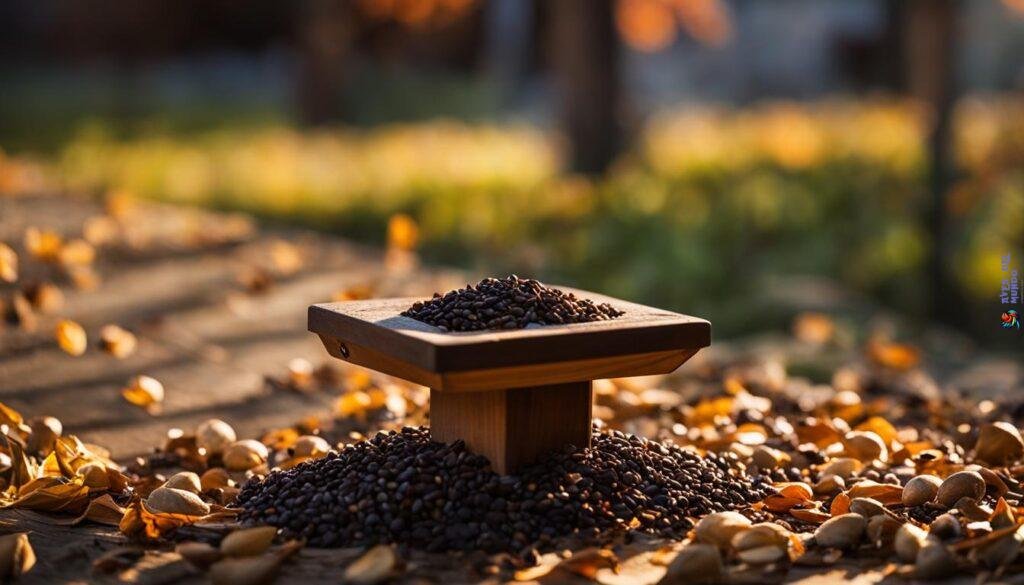
Add Enticements to Attract the Birds
Birds need water as much as they need food. Providing a bird bath with clean, fresh water will attract birds and serve as a source of refreshment.
Enhance the appeal by adding moving water features such as a dripper, fountain, wiggler, or mister. The sound and reflection of moving water will attract more birds to your garden.
Here are some water features you can consider:
A Dripper
A dripper is a simple device that creates a gentle drip or trickle of water into the bird bath. The sound and motion of the dripping water will catch the attention of birds, increasing their interest in your garden.
A Fountain
A fountain not only adds a visually appealing element to your bird bath but also provides a continuous flow of water. The movement and sound will attract birds from a greater distance, making your garden a popular spot for them to drink and bathe.
A Wiggler
A wiggler is a device that can be placed in the bird bath to create tiny ripples and movements in the water. The natural motion simulates the effect of insects or small prey, attracting birds that rely on these food sources.
A Mister
A mister is a device that produces a fine spray or mist of water. Birds, particularly those that enjoy bathing, such as sparrows and finches, are drawn to the mist and will appreciate the opportunity to clean their feathers in a refreshing spray.
Adding these enticements to your bird bath will not only provide a water source for birds but also create a captivating and inviting environment that attracts a wider variety of species.
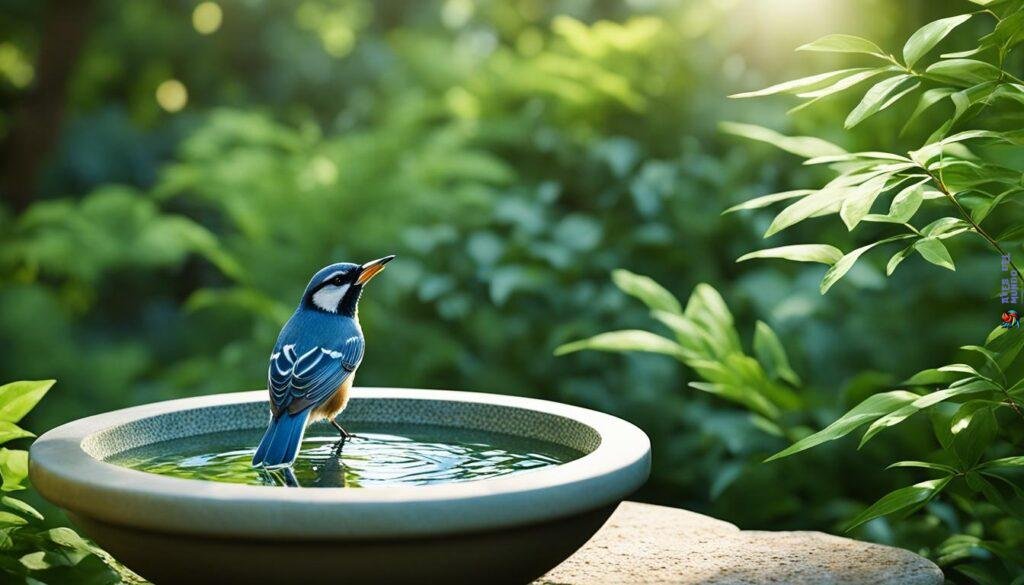
Be Patient
Introducing a new feeder or food source to your garden may require some patience. Birds have their own feeding habits and preferences, and it may take time for them to adjust to a new addition. Don’t be discouraged if they don’t immediately flock to the feeder you’ve set up.
Give the birds time to discover and explore the new food source. It could take a couple of weeks before they start interacting with it. Remember, birds are creatures of habit, and they may be hesitant to change their feeding routine. Be patient, and soon enough, they’ll be enjoying the treats you’ve provided.
Spring migration is an ideal time to introduce a new feeder. As birds return from their winter journey, they’ll be hungry and searching for reliable food sources. By offering a backyard feast during this time, you’ll attract a variety of bird species and create a thriving hub of activity in your garden.



